

Ohio University is one of the largest users of energy in the state of Ohio. As such, we need to be particularly careful to make sure that our energy use is sustainable, meaning that it simultaneously benefits people, the planet, and prosperity both now and in the future. The use of renewable energy, while not perfect, has the potential to reduce current and long-term impacts to public health, the environment, and the operational costs of the University, and to improve resiliency in the event of natural disasters. Ohio University is proud to be a US EPA Top 30 College and University Green Power Partner for its purchase of renewable energy credits (RECs) for 100% of its electricity usage. The University is actively pursuing solar installations for all of its campuses.
The Sustainability Project Laboratory is a database of sustainability-related project proposals. This resource hosts projects and project ideas that can be adopted by faculty, staff, and students for course projects, capstone or senior projects, theses, and more on the Sustainability Project Laboratory website.
To find energy related projects just type "energy" into the search bar at the top of the Project Database.
The Association for the Advancement of Sustainability in Higher Education (AASHE) is currently revising its Sustainability Tracking, Assessment & Rating System (STARS), which Ohio University uses to measure its sustainability efforts. View a Draft of the Proposed Updates
Data
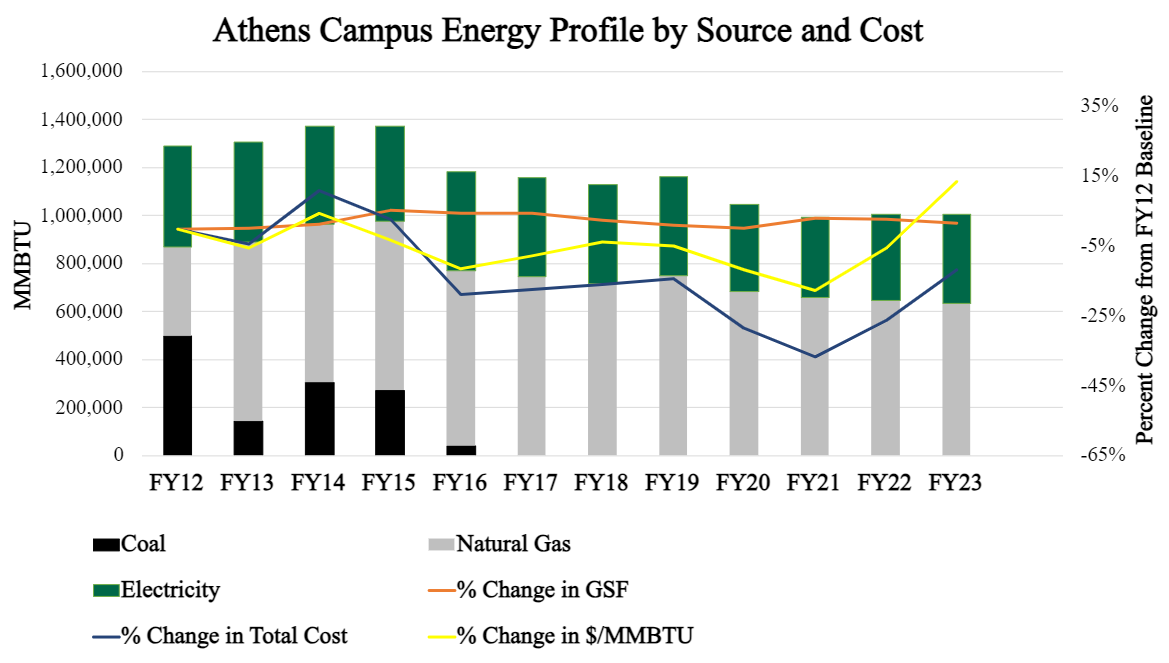
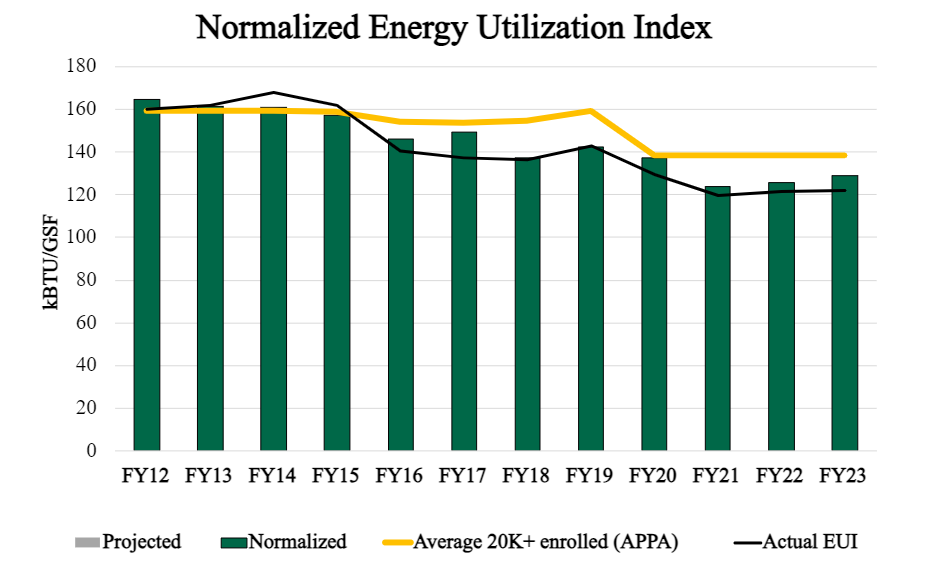
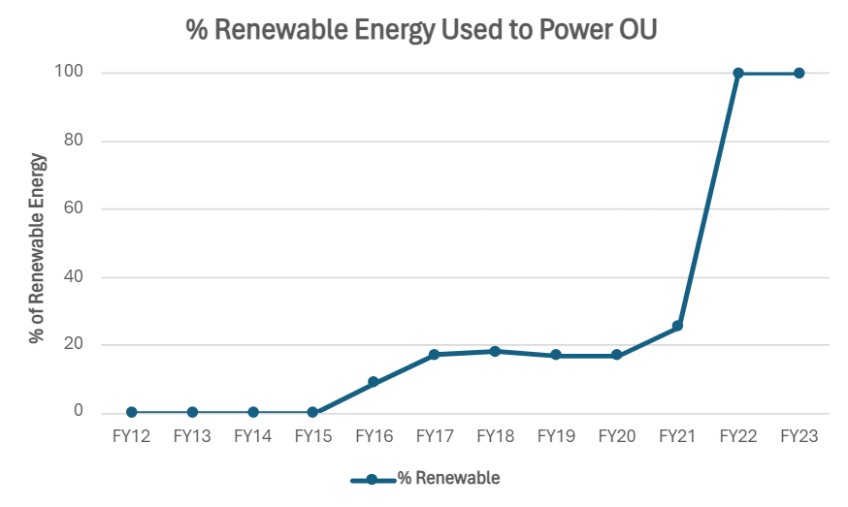
Ohio University Sustainability Plans
Moving Forward: 2021-2026 Sustainability & Climate Action Plan Goal #1
Goal 1: Reduce campus and building energy intensity from 137 average kBtu/ft 2 to 110 average kBtu/ft 2 .
Potential Strategies
-
Create and implement Ohio University Low Impact Building Standards for construction/renovation projects which align with our sustainability commitments. Low Impact will be defined in the aforementioned standard.
-
Expand and institutionalize OHIO Sustainable Building Operations & Maintenance program
-
Restart building energy competitions; educate OHIO campus and communities about energy efficiency
Benefits of Goal #1
- Reduced operation costs, specifically in electrical and natural gas bills
- Reduced emissions
- Increased occupant comfort and productivity
- Enhanced academic quality
Costs of Goal #1
- Capital expenses
- Increased maintenance costs
Moving Forward: 2021-2026 Sustainability & Climate Action Plan Goal #2
Goal 2: Decrease reliance on fossil fuel energy, hereby increasing the percent of renewable energy (defined by AASHE STARS, p 5 of Technical Manual, OP6) in electricity, cooling, heating, and transportation (including, but not limited to, gasoline & diesel used to operate OHIO fleet vehicles, as well as fuels used in commuting by faculty, staff & students, as required by the SIMAP Reporting Platform from 18% to 36%
Potential Strategies
-
Pursue innovative and sustainable renewable energy options for all or parts of campus energy
-
Consider regional campuses for siting of large on-site renewables
Benefits of Goal #2
- Reduced operating expenses
- Reduced carbon emissions
- Increased resiliency benefits
Costs of Goal #2
- Capital expenses
- Maintenance costs
2011-2021 Sustainability & Climate Action Plan
-
Benchmark 1: Reduce institutional greenhouse gas emissions. Target of 25% below baseline exceeded. Between Fiscal Year 2012 (FY12) and FY18, net emissions decreased by 30%.
-
Benchmark 2: Reduce campus and building energy intensity. Nearing target of 20% reduction from 2004 baseline at 15% reduction.
-
Benchmark 3: Increase renewable energy. Nearing target of 20% renewables at 17.9%.
Energy Graphics
AASHE STARS compares programs across the nation in many different categories. Ohio University reports above the national average in energy.
At Ohio University, energy makes up about two-thirds of the carbon emissions, and therefore, is the largest sub-category by a wide margin. This is because buildings , the largest user of energy, is the largest category. For comparison, the next largest carbon polluter is transportation , which composes just over a quarter of total carbon emissions.
Initiatives
2023 Initiatives
| Infrastructure Hub Supported Initiatives | SCAP Alignment |
|---|---|
| Lausche Heating Plant Tours: Due to new safety protocols at Lausche the Engineering student led tours of Lausche for both heating and cooling systems, focusing on how city water is turned into steam for boilers and cooled for air conditioning units, are currently on hold. The tour also discusses the switch from coal to natural gas. Read more about Lausche . | Decrease reliance on fossil fuel energy; Increase faculty, student, and community engagement across hub themes. |
| Renewable Energy Educational Trailer: Students of SP24 ME2800 had the opportunity to work on original diagrams for a renewable energy trailer. This trailer will showcase how solar, wind, and hydroelectric renewable energy works on a small scale. Grant funding for this project is currently being sourced | Increase faculty, student, and community engagement across hub themes; Decrease reliance on fossil fuel energy; |
| Solar Panel Estimation for the new Ecohouse: Students of SP24 had the opportunity to work on estimation of costs and draw diagrams for solar panels needed for the anticipated new ecohouse. | Decrease reliance on fossil fuel energy |
2022 Initiatives
| Infrastructure Hub Supported Initiatives | SCAP Alignment |
|---|---|
| Energy Efficiency Audit Treasure Hunt: With funding from the Student Success team, students in ME 4930 Special Investigations: Building Energy Treasure Hunt were given an opportunity to gain hands-on experience on the process of performing an energy audit in Shively Hall. | Reduce campus and building energy intensity; Increase faculty, student, and community engagement across hub themes. |
| Renewable Energy Expansion: The Office of Sustainability is leading the development of on-site renewable energy resources at OHIO campuses. In 2023, ~1MW solar arrays may be developed on the Lancaster and Chillicothe campuses, lowering costs and providing experiential learning opportunities for students. | Decrease reliance on fossil fuel energy |
2021 Initiatives
| Infrastructure Hub Supported Initiatives | SCAP Alignment |
|---|---|
| Sustainability Project Laboratory: Website of sustainability projects developed for curricular purposes |
Increase faculty, student, and community engagement across all hub themes. |
| Triple Bottom Line Cost Benefit Analysis (TBL CBA) Tool: Framework for assessing sustainability impacts. |
Communication and decision-making tool for use in all hub themes. |
| Energy conservation: On-campus energy efficiency projects |
Reduce campus and building energy intensity; Decrease reliance on fossil fuel energy |
| Renewable RFP: Request for bid on renewable energy projects |
Decrease reliance on fossil fuel energy |
| Sustainable Infrastructure Hub Related Initiatives | SCAP Alignment |
|---|---|
| Steam system annual shut down: (Maintenance & Operations) Corrective & preventative maintenance best practices |
Maintain and operate existing buildings to reduce impacts; Decrease reliance on fossil fuel energy |
| Energy dashboard: (Energy Management) Development of dashboard for energy management |
Maintain and operate existing buildings to reduce impacts; Decrease reliance on fossil fuel energy |
Renewable Energy Initiatives
Building 22/Ridges Solar Installment, 2.34 kW
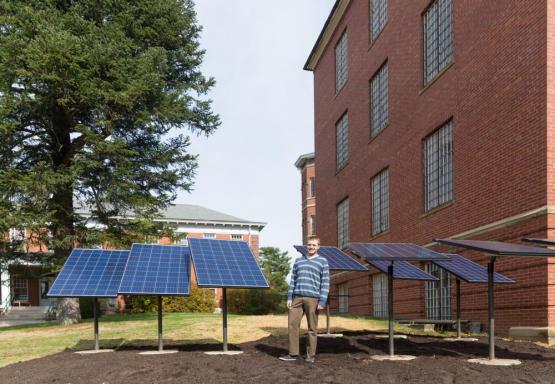
Nine 260 W (DC) solar panels were installed next to Building 22 on the Ridges by Athena Solar Panels in October, 2016. The installation project was initially managed by a graduate student in Environmental Studies, Alex Burke, and data from the panels was used in his master's thesis. Output from the array is tracked through an Enphase Enlighten dashboard.
Storage Shed Solar Installment, 61.1 kW
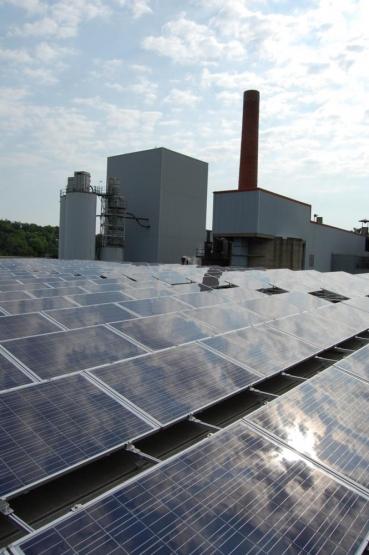
This project was completed in 2012 and included: the installation of a 61.1 kW photovoltaic array by Dove Tail Solar and Wind on the roof of the storage shed adjacent to the Lausche Heating Plant; the installation of safety rails; and dedicated access to the roof in order to accommodate equipment maintenance. An architectural and engineering analysis concluded that structural upgrades to the storage shed were unnecessary. Output from the array is monitored through a sub-meter that is available for use for educational purposes.
Compost Facility Solar, 41.1 kW
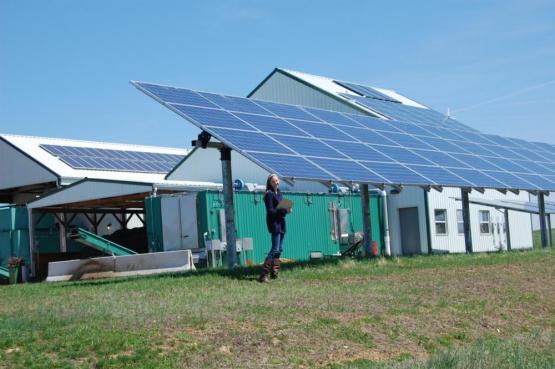
Ohio University is home to the largest in-vessel compost system at any college or university in the nation. There are currently 41.1 kW of photovoltaic panels at the Compost Facility. A 10kW system was installed in 2008 by Dovetail Solar and Wind, and a 31.1kW system was installed in 2012. The compost facility also has Solar Thermal mounted on the roof of the second building. The Solar Thermal system heats the greywater used to clean the compost bins. Output from the arrays is hand tracked daily by compost operators.
OHIO Ecohouse, 2.4kW
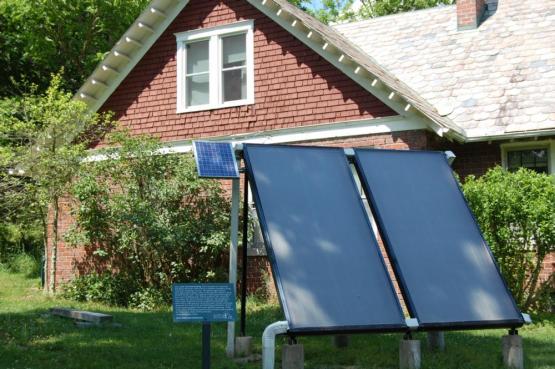
The OHIO Ecohouse is a residential learning experience for off-campus-eligible students at Ohio University. A 2.4 kW was installed in 2005 by Dovetail Solar and Wind. The system is mounted on a tall frame in the yard of the Ecohouse since the house is situated in a holler and, therefore, does not have access to direct sunlight. On the opposite side of the house is a small Solar Thermal system that helps reduce the energy used for heating water for the residents. Output from the solar systems is tracked through EnergyCAP.
The PV array at the OHIO Ecohouse is mounted to a raised frame to optimize access to sunlight. The Solar Thermal system at the OHIO Ecohouse helps reduce the amount of energy dedicated to heating the water used by the residents.
Innovation Center, 4 kW
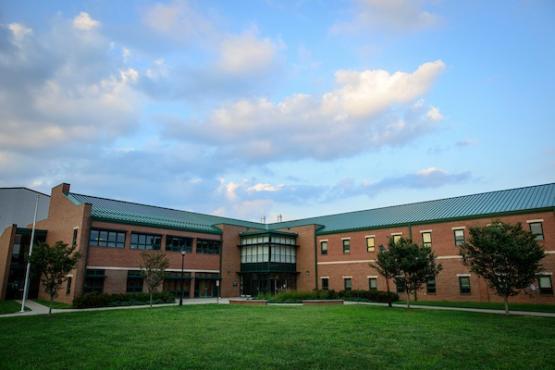
The Innovation Center at Ohio University has one of the oldest and the most unique solar installation on campus. In 2003, Third Sun Solar and Wind Power installed 32 UniSolar PVL 124 W thin-film laminate panels to the Innovation Center roof. The laminates adhere directly to the metal roof of the Innovation Center and are visible as a darker color in the top left corner of the roof in the picture below. Generation from this array is tracked only by occasional manual reading of the meter located in the mechanical room of the Innovation Center.
Other Solar PV Systems
Two other PV arrays were installed in 2003 by Third Sun Solar and Wind Power. The West Green Chilled Water Plant has a 2.4 kW PV array and Chubb Hall has a 0.33 kW PV array. The generation from these older arrays is not currently tracked by Ohio University.
All solar PV systems at Ohio University are grid-tied.
Experts and Stakeholders on Sustainable Energy
Ohio University Experts on Sustainable Energy
| Name | Contact | Position and Research Interests |
|---|---|---|
|
Cody Petit
|
petittc@ohio.edu | Sustainable Infrastructure Hub Coordinator and Assistant Professor in Mechanical Engineering |
|
Sam Crowl
|
crowls1@ohio.edu | Director of Sustainability |
|
Jesús Pagán
|
paganj@ohio.edu | Associate Professor of Engineering Technology & Management |
|
Kim Miller
|
millerk8@ohio.edu | Bioenergy systems; greenhouse gas cycling |
|
Sarah Davis
|
daviss6@ohio.edu | Associate Professor of Voinovich School of Leadership & Public Service Landscape and forest ecology; bioenergy; circular economies |
|
Timothy Cyders
|
cyderst@ohio.edu | Associate Professor of Mechanical Engineering Sustainable power generation |
|
Greg Kremer
|
kremer@ohio.edu | Chair of Mechanical Engineering Energy engineering; alternative energy systems |
|
Eric Stinafff
|
stinaff@ohio.edu | Professor & Chair of Physics and Astronomy Smart photo-voltaic and energy storage devices, quantum dots |
|
Adam Riehl
|
riehl@ohio.edu | Director, Facilities Management for Regional Higher Education Energy efficiency |
|
Jason Trembley
|
trembly@ohio.edu | Professor of Mechanical Engineering Electrochemical capture of nutrients from waste streams, water remediation, and sustainable composite materials |
|
Elaine Goetz
|
goetze@ohio.edu | Director of Energy Management and AVP Facilities Administration |
Other Stakeholders & Experts on Sustainable Energy
| Name | Contact | Description |
|---|---|---|
|
Rural Action
|
https://ruralaction.org/our-work/sustainable-energy-solutions | A nonprofit that focuses on public and environmental enrichment projects in Appalachian Ohio |
Frequently Asked Questions on Sustainable Energy
Note: These questions were originally asked and answered for the Davidson College Energy FAQ. They were created by Claire Naisby, who was an energy manager at Davidson and then a Building Systems Integration Manager at Ohio University.
Sustainable Energy Q & A
Where does the electricity (kWh) at Ohio University come from?
Ohio University purchases most of its electricity from AEP Energy . AEP Energy is a Competitive Retail Electric Supplier (CRES) in Ohio. Learn about competition in retail electricity markets . AEP Ohio provides transmission and distribution of the electricity. Ohio University also owns and operates more than 100 kW of grid-tied solar PV.
What is the energy resource mix used to generate Ohio University's electricity?
Ohio University purchases Green-e certified renewable energy certificates (RECs) for 50% of all electricity used on its Athens, Dublin and regional campuses. The RECs are purchased through AEP Energy and are from wind power. The other 50% of the electricity is purchased through AEP Energy from regional generation sources that use a mix of Coal fired power plants (33%), Nuclear power plants (37%), Natural Gas fired plants (25%), Wind (2.5%), Hydro (1.5%), Biomass (0.5%), and Other (0.5%) (projected data for 2017). AEP Energy's Environmental Disclosures Which Detail Their Generation Sources
What are the factors affecting electricity prices?
Power companies must have generation capacity equal to the maximum momentary demand of its customer base. At all other times, power companies have excess capacity. Ohio University controls a portion of its energy cost by managing its peak energy consumption by shifting loads in our West Green Chilled Water Plant; as the campus approaches its peak consumption each day, the facilities team utilizes the steam turbine chiller for as much load as possible instead of our electric chillers.
Learn more about the factors that affect electrical prices - EIA Electricity Prices and AEP OHIO Winter Bill Help . Ohio is a competitive choice state regulated by the Public Utilities Commission of Ohio . Learn how that affects the state's energy prices.
How much electricity does Ohio University use?
In the last three years Ohio University has purchased the following:
FY2017-18: 120,932,884 kWh
FY2018-19: 121,114,302 kWh
FY2019-20*: 106,155,635 kWh
*The COVID-19 pandemic began in early March 2020, and impacted electricity usage.
Weather, building square footage, and energy initiatives play a role in the electricity usage at Ohio University. Please see FAQ #6 for natural gas usage.
How is the campus heated and cooled?
The central steam plant, Lausche , houses four steam boilers that supply steam to most of the buildings on the Athens campus north of the Hocking River. The steam boilers are fueled by natural gas, and can use ultra-low sulfur diesel fuel as a backup. Since Thanksgiving, 2015 coal has not been used in the steam boilers. Steam is used to heat buildings, generate domestic hot water, run absorption chillers and a condensing steam turbine chiller, and for some cooking, steam dryers, and laboratory research.
Much of the campus is cooled by chilled water that is generated by central chillers located in the West Green Chilled Water Plant (WGCWP) and as of spring 2021 by the Chilled Water Plant 3 (CWP3). WGCWP houses two electric chillers and one condensing steam turbine chiller (2500 tons of cooling each: a cooling ton is equal to the amount of heat needed to melt one ton of ice in 24 hours). The WGCWP plant delivers chilled water needed by the campus using 6 main chilled water pumps.
There are several buildings based cooling systems with their own chillers throughout campus. Some less modern buildings use window AC units.
The buildings have various kinds of Air Handling Units (AHUs) and Fan Coil Units (FCUs) and many other technologies that supply conditioned air to the occupied spaces.
How much natural gas does the heating plant purchase each year and where does it come from?
Ohio University purchases its natural gas for Lausche from IGS Energy, a privately-held, Ohio-based corporation which delivers all of natural gas to the campus through our local distributor, Columbia Gas.
In the past 3 years, the University has used the following amounts of natural gas and #2 ultra-low sulfur diesel fuel (totals include both; the majority of the fuel usage is natural gas since the diesel fuel is only used as a backup):
FY2017-18: 715,564 MMBtu
FY2018-19: 748,076 MMBtu
FY2019-20*: 686,667 MMBtu
*The COVID-19 pandemic began in early March 2020, and impacted electricity usage.
Why does Ohio University no longer use coal for heating?
To satisfy climate action goals and an agreement with the local Sierra Club chapter, Ohio University converted from coal fired boilers to natural gas fired boilers in 2015. Natural gas fired boilers produce substantially less, about half, the carbon dioxide that is produced by a coal fired boiler of the same capacity. Ultra-low sulfur diesel fuel is used only as an emergency backup for periods when natural gas service is curtailed.
How is the temperature in campus buildings controlled?
Most of the academic and office buildings are controlled by an energy management and control system utilizing Direct Digital Controls (DDC). There are manual thermostats in several residence halls and independent residences. The manual controls are replaced with digital as the systems are upgraded.
The temperature of each occupied space in the buildings with DDC controls is set based on Ohio University Facilities Management set point guidelines. The energy management system maintains a balance between occupant comfort level, humidity control, and energy efficiency.
Which renewable energy systems are being considered for the campus?
Any and all renewable energy systems and purchases of renewable energy are being considered for the campus, including on-site and off-site solar farms, off-site wind farms, low-head hydroelectric power plants, solar thermal, geothermal systems, power purchase agreements (PPAs) and renewable energy certificates (RECs). The Sustainability Plan goal of 20% renewable energy generation by 2020 was met through REC purchases in 2015. The Sustainability and Climate Action Plans are currently being revised, and new renewable energy milestones will be outlined in the revised plans. Renewable energy systems will be evaluated for sustainability, and any chosen system will need to simultaneously benefit our campus community, the environment, and our economy.
Is Ohio University engaged in any ongoing energy projects?
- Sub-metering utilities at the building level. Electrical, steam, condensate, domestic water and chilled water meters projects are all underway
- Building control systems (DDC) integration and scheduling.
- Steam system shut-down. Each year in May, the steam generation and distribution system is shut down for maintenance, repairs, and upgrades. This is a yearly opportunity to practice our most important energy priority, conservation, by finding and repairing leaks and replacing inefficient equipment.
- A program for regular retro-commissioning of older buildings is in the planning stage. Buildings are currently commissioned when built or renovated, but older buildings need "tune-ups" to bring them to higher levels of energy efficiency.
- Lighting upgrades have been completed; Architecture, Design & Construction standards are being updated to reflect the most energy-efficient lighting standards.
- Ohio University entered the 2016 Energy Star National Building Competition: Bootcamp! to raise awareness of energy usage and conservation on campus.
How can I save energy in my dorm, office, or home life?
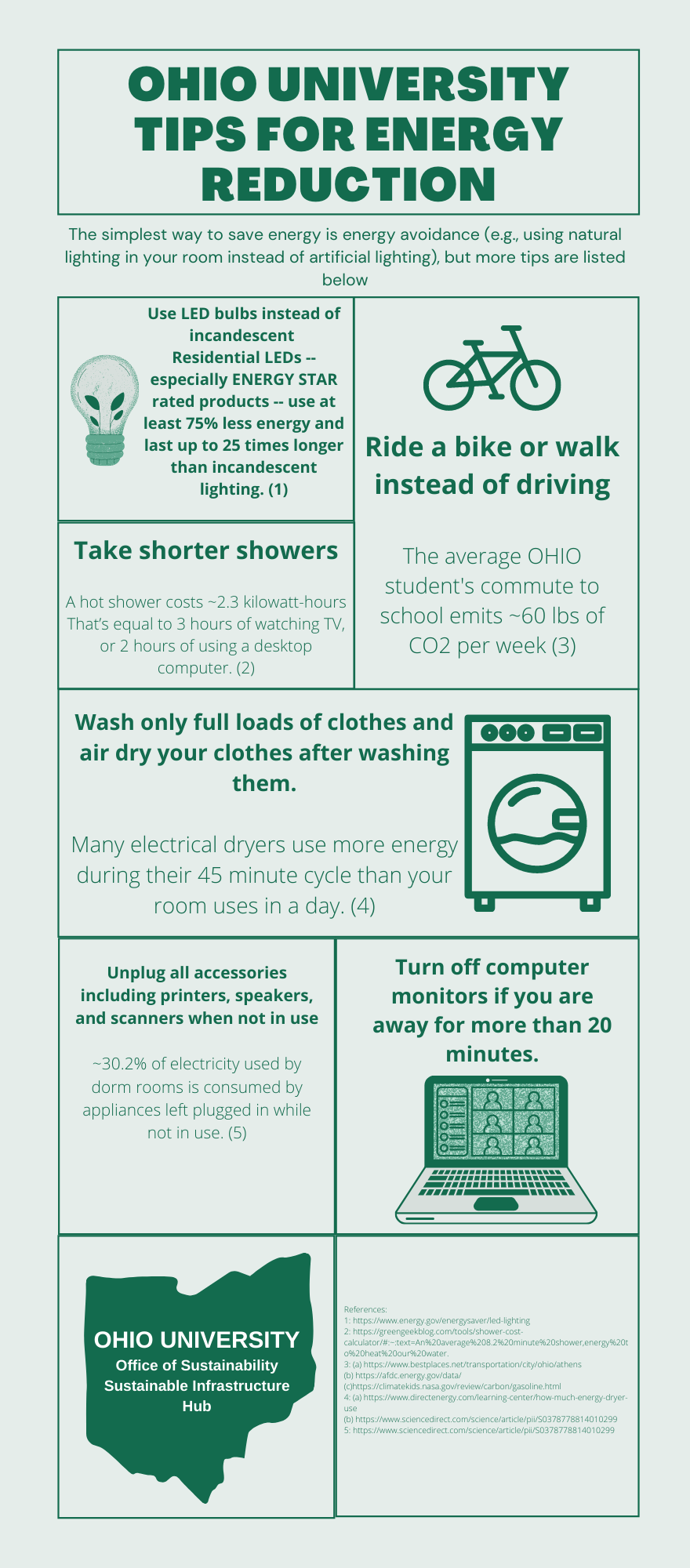
The simplest way to save energy is energy avoidance (e.g., using natural lighting in the room instead of artificial lighting), but more tips are listed below. You can also find suggestions on the " Tips for Sustainability " page.
- Use LED bulbs instead of incandescent.
- Turn off lights when you leave a room.
- Set your thermostat a few degrees lower in the winter and a few degrees higher in the summer.
- Do not use space heaters.
- Turn off computer monitors and/or enable sleep mode on computers if you are away for more than 20 minutes.
- Unplug all accessories including printers, speakers, and scanners when not in use.
- If you don't need extra light while you're working on a computer, switch off desk lamps and overhead lights.
- Consider plugging appliances into a power strip that can be easily switched off when you're leaving the office or dorm. Some power strips can detect when appliances are not in use and switch off automatically.
- Take shorter showers.
- Ride a bike, walk, or take public transportation instead of driving a car.
- Wash only full loads of clothes and air dry your clothes after washing them. Many electrical dryers use more energy during their 45 minute cycle than your room uses in a day.
- In conditioned rooms keep windows closed, so we can help you better control the temperature and humidity in your room.
- Dress for the weather.

